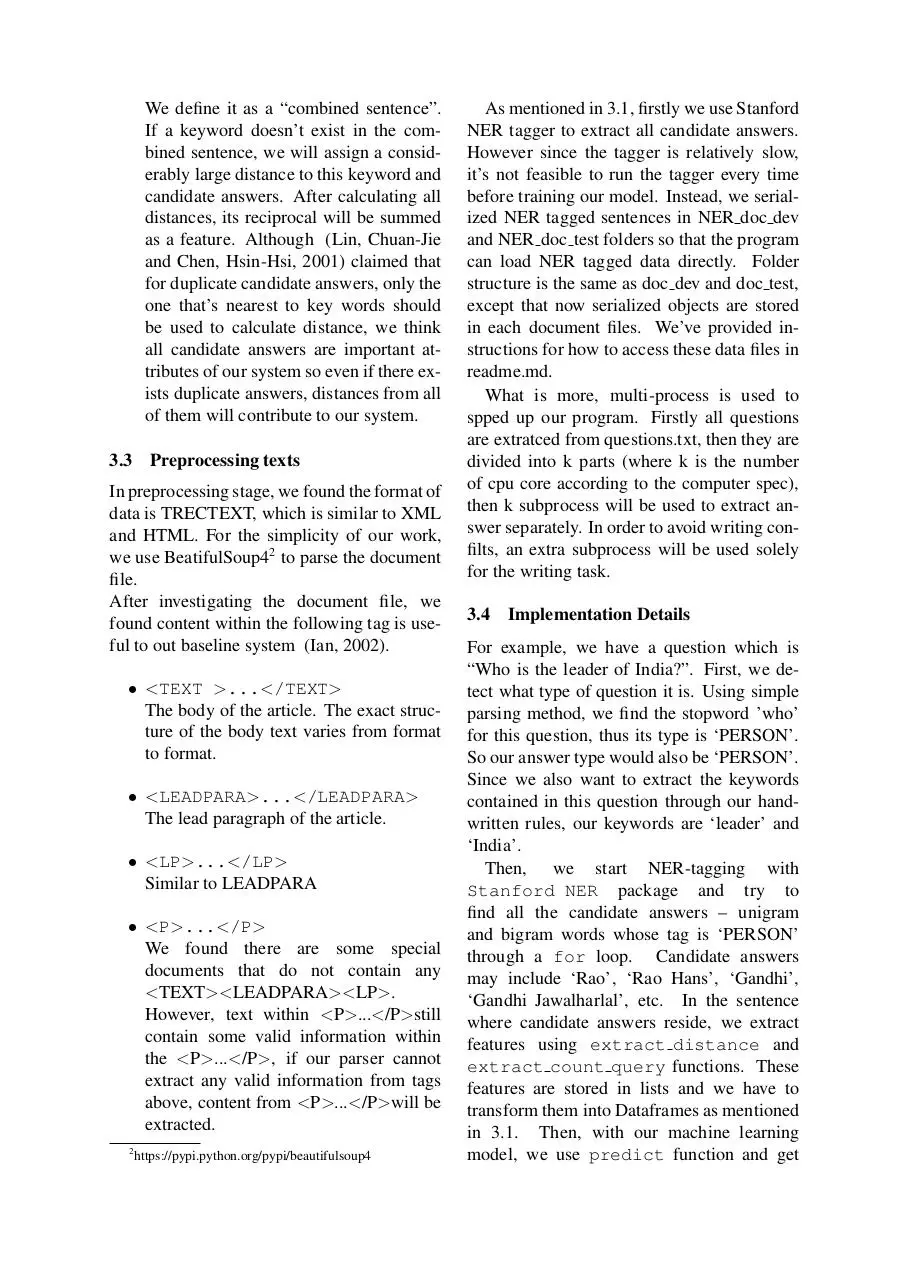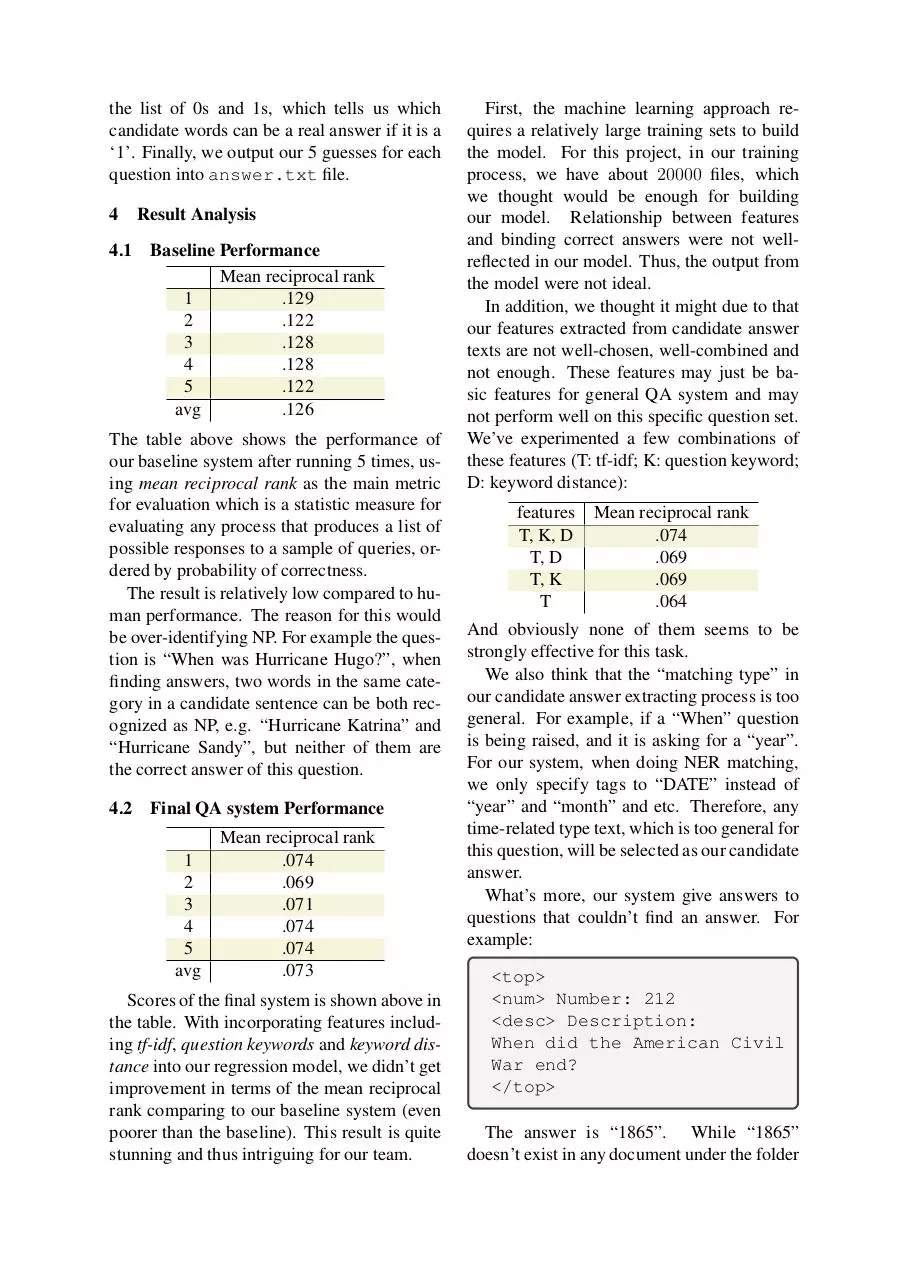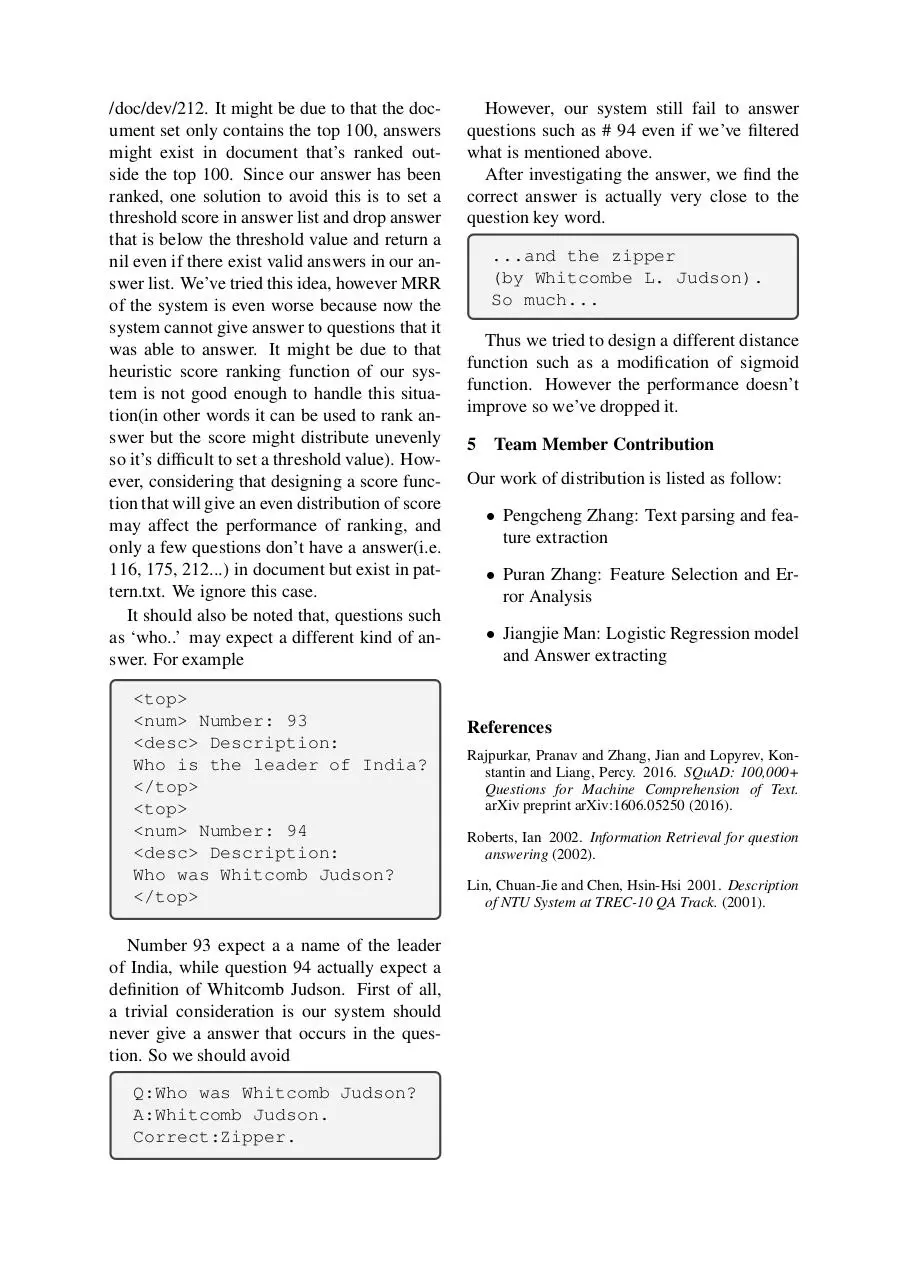CS5740 Project 3 Report (PDF)
File information
This PDF 1.5 document has been generated by TeX / pdfTeX-1.40.16, and has been sent on pdf-archive.com on 30/11/2016 at 16:19, from IP address 67.249.x.x.
The current document download page has been viewed 457 times.
File size: 115.58 KB (5 pages).
Privacy: public file





File preview
CS5740 P3 Question Answering Report
Pengcheng Zhang
pz84@
1
Jiangjie Man
jm2559@
Introduction
In this report, we describe how our QuestionAnswering system was implemented and
compared its performance with the baseline
system we built in part I. For our QA system in part II, we use NER tagger for answer
type detection and build a logistic regression
model for extracting candidate sentences and
extracte several types of features for each candidate answer. Features we choose to incorporate are the “TF-IDF score” and “keyword
distance” as well as the “number of matching
keywords” to help our final model pick the
correct sentences. We also include the evaluation and analysis of our QA system’s performance compared with our baseline system.
2
Baseline System
Our baseline system is consist of several modules, a Question module, an Answer module
and a last module in charge of producing and
outputting the answers. The Question class
defines a question object which can be used
to parse, tagged and classified. Every question is a string obtained from input files. The
Answer class gives 5 guesses and 5 document
ids ranked from top to the fifth for each answer. It uses nil as the answer-text if the system finds no answer for a particular question.
The answer-text should be 10 or fewer words.
In particular, when pre-processing the data,
after valid text is extracted from the raw document file, we extracted “keyword” – noun
phrase (NP) from the question using NLTK’s
pos-tagger. To determine the frontiers of this
noun phrase, we define a local grammar for
the NP in English, such as “Adjective + Proper
Noun”.
Then, for each question, we matched the
keywords with text data in the documents by
sentences. If the candidate sentence contains
Puran Zhang
pz75@
keywords, we striped all the keywords in the
sentence and then extracted NPs in the sentence. All these NPs are stored in a frequency
dictionary where we sorted the top 5 NPs to
be our guesses for answer.
3
Final QA System
Based on the performance of our baseline system, which is a naive matching-word system,
we decided to explore machine learning methods/models. In the baseline, we deployed
hand-written rules to extract answers. However, these rules are very time consuming.
We cannot merely learn what we need to perform classification from examples since rules
are hard-coded. Besides, when new question
types arise, the system is not able to handle
them appropriately. New rules must be written by hand to cover these new types. In addition, if it is decided that we need to use a new
set of answer types, it is probable that many
rules will need to be rewritten. Finally, it is
even more difficult to extend the answer types
to more specific types.
We incorporated the tf-idf, which is a
weighting factor that reflects how important
a word is to a document in a collection or
corpus, to help our final model pick the correct sentences. In addition, we used length
features to bias our model towards picking
common lengths and positions for answer
spans. Span word frequencies were integrated
to help us bias the model against uninformative words. Furthermore, according to the paper on SQuAD (Rajpurkar, et al., 2016), we
used constituent label and span POS tag features to guide the model towards the correct
answer types.
3.1
Overall Architecture
features (X) and true label (Y)
using sklearn package. Specifically, We first convert both X and
Y into DataFrame and then use
sklearn.linear model.LogisticRegression
fit function to train our model.
In this system, we built our logistic regression
model for predicting answers with the training sets (in the “doc dev” folder) in baseline
phase. The training process is listed below:
• Processing question texts
– First, we did the answer type detection by simply extracting and classifying question words (who, when,
where) in those questions in our
training sets;
– We then extracted keywords from
question sets, preparing for subsequent matching tasks. In the keywords extraction algorithm, we followed selecting all non-stop words
and then all NNP words in recognized named entities;
• Extracting candidate answers
– We used Stanford Named Entity
Recognizer1 to label sequences of
words that are named entities in
candidate texts;
– Then we extracted features (name
them X) such as tf-idf from these
candidate answer texts;
• Matching pattern.txt with candidate
answers
– With extracted candidate answers,
we compared/matched them with
pattern.txt, which is the actual answer. Specifically, we matched each
of the candidate answer with the
regular expression in pattern.txt and
scored (candidate answer) with 0 (as
dis-matched) and 1 (as matched).
We name this as Y ;
• Training with Logistic Regression
Model
– Now with X and Y , we trained
our logistic regression model that
predicts answers with inputing
1
http://nlp.stanford.edu/software/CRF-NER.shtml
• Testing
– After training, we can predict which
candidate answer is the correct answer according to our logistic regression model. The testing process
is similar to training, but we only
extract features from candidate answers which are selected by NER
tagger in the test documents.
3.2
Features
• TF-IDF:
TF-IDF, short for term frequencyinverse
document frequency, is considered as a
feature of our system. Since this value
has been given in each document, we
haven’t calculated it our self. Instead, we
just used the score in each document.
• Question keywords:
It’s the number of question keywords in
a single candidate sentence. We think it
may be a good indicator to select candidate answers.
• Keyword distance
It’s the distance in words between the
candidate and query keywords. Since
candidate answer is extracted from document, it’s guaranteed that candidate will
be located in current sentence. However,
keyword may or may not exist in the document. Here we only consider the distance of a keyword if it’s in current sentence or neighbour sentence as shown below.
We define it as a “combined sentence”.
If a keyword doesn’t exist in the combined sentence, we will assign a considerably large distance to this keyword and
candidate answers. After calculating all
distances, its reciprocal will be summed
as a feature. Although (Lin, Chuan-Jie
and Chen, Hsin-Hsi, 2001) claimed that
for duplicate candidate answers, only the
one that’s nearest to key words should
be used to calculate distance, we think
all candidate answers are important attributes of our system so even if there exists duplicate answers, distances from all
of them will contribute to our system.
3.3
Preprocessing texts
In preprocessing stage, we found the format of
data is TRECTEXT, which is similar to XML
and HTML. For the simplicity of our work,
we use BeatifulSoup42 to parse the document
file.
After investigating the document file, we
found content within the following tag is useful to out baseline system (Ian, 2002).
• <TEXT >...</TEXT>
The body of the article. The exact structure of the body text varies from format
to format.
• <LEADPARA>...</LEADPARA>
The lead paragraph of the article.
• <LP>...</LP>
Similar to LEADPARA
• <P>...</P>
We found there are some special
documents that do not contain any
<TEXT><LEADPARA><LP>.
However, text within <P>...</P>still
contain some valid information within
the <P>...</P>, if our parser cannot
extract any valid information from tags
above, content from <P>...</P>will be
extracted.
2
https://pypi.python.org/pypi/beautifulsoup4
As mentioned in 3.1, firstly we use Stanford
NER tagger to extract all candidate answers.
However since the tagger is relatively slow,
it’s not feasible to run the tagger every time
before training our model. Instead, we serialized NER tagged sentences in NER doc dev
and NER doc test folders so that the program
can load NER tagged data directly. Folder
structure is the same as doc dev and doc test,
except that now serialized objects are stored
in each document files. We’ve provided instructions for how to access these data files in
readme.md.
What is more, multi-process is used to
spped up our program. Firstly all questions
are extratced from questions.txt, then they are
divided into k parts (where k is the number
of cpu core according to the computer spec),
then k subprocess will be used to extract answer separately. In order to avoid writing confilts, an extra subprocess will be used solely
for the writing task.
3.4
Implementation Details
For example, we have a question which is
“Who is the leader of India?”. First, we detect what type of question it is. Using simple
parsing method, we find the stopword ’who’
for this question, thus its type is ‘PERSON’.
So our answer type would also be ‘PERSON’.
Since we also want to extract the keywords
contained in this question through our handwritten rules, our keywords are ‘leader’ and
‘India’.
Then, we start NER-tagging with
Stanford NER package and try to
find all the candidate answers – unigram
and bigram words whose tag is ‘PERSON’
through a for loop. Candidate answers
may include ‘Rao’, ‘Rao Hans’, ‘Gandhi’,
‘Gandhi Jawalharlal’, etc. In the sentence
where candidate answers reside, we extract
features using extract distance and
extract count query functions. These
features are stored in lists and we have to
transform them into Dataframes as mentioned
in 3.1. Then, with our machine learning
model, we use predict function and get
the list of 0s and 1s, which tells us which
candidate words can be a real answer if it is a
‘1’. Finally, we output our 5 guesses for each
question into answer.txt file.
4
4.1
Result Analysis
Baseline Performance
Mean reciprocal rank
1
.129
.122
2
3
.128
.128
4
5
.122
avg
.126
The table above shows the performance of
our baseline system after running 5 times, using mean reciprocal rank as the main metric
for evaluation which is a statistic measure for
evaluating any process that produces a list of
possible responses to a sample of queries, ordered by probability of correctness.
The result is relatively low compared to human performance. The reason for this would
be over-identifying NP. For example the question is “When was Hurricane Hugo?”, when
finding answers, two words in the same category in a candidate sentence can be both recognized as NP, e.g. “Hurricane Katrina” and
“Hurricane Sandy”, but neither of them are
the correct answer of this question.
4.2
Final QA system Performance
1
2
3
4
5
avg
Mean reciprocal rank
.074
.069
.071
.074
.074
.073
Scores of the final system is shown above in
the table. With incorporating features including tf-idf, question keywords and keyword distance into our regression model, we didn’t get
improvement in terms of the mean reciprocal
rank comparing to our baseline system (even
poorer than the baseline). This result is quite
stunning and thus intriguing for our team.
First, the machine learning approach requires a relatively large training sets to build
the model. For this project, in our training
process, we have about 20000 files, which
we thought would be enough for building
our model. Relationship between features
and binding correct answers were not wellreflected in our model. Thus, the output from
the model were not ideal.
In addition, we thought it might due to that
our features extracted from candidate answer
texts are not well-chosen, well-combined and
not enough. These features may just be basic features for general QA system and may
not perform well on this specific question set.
We’ve experimented a few combinations of
these features (T: tf-idf; K: question keyword;
D: keyword distance):
features
T, K, D
T, D
T, K
T
Mean reciprocal rank
.074
.069
.069
.064
And obviously none of them seems to be
strongly effective for this task.
We also think that the “matching type” in
our candidate answer extracting process is too
general. For example, if a “When” question
is being raised, and it is asking for a “year”.
For our system, when doing NER matching,
we only specify tags to “DATE” instead of
“year” and “month” and etc. Therefore, any
time-related type text, which is too general for
this question, will be selected as our candidate
answer.
What’s more, our system give answers to
questions that couldn’t find an answer. For
example:
<top>
<num> Number: 212
<desc> Description:
When did the American Civil
War end?
</top>
The answer is “1865”. While “1865”
doesn’t exist in any document under the folder
/doc/dev/212. It might be due to that the document set only contains the top 100, answers
might exist in document that’s ranked outside the top 100. Since our answer has been
ranked, one solution to avoid this is to set a
threshold score in answer list and drop answer
that is below the threshold value and return a
nil even if there exist valid answers in our answer list. We’ve tried this idea, however MRR
of the system is even worse because now the
system cannot give answer to questions that it
was able to answer. It might be due to that
heuristic score ranking function of our system is not good enough to handle this situation(in other words it can be used to rank answer but the score might distribute unevenly
so it’s difficult to set a threshold value). However, considering that designing a score function that will give an even distribution of score
may affect the performance of ranking, and
only a few questions don’t have a answer(i.e.
116, 175, 212...) in document but exist in pattern.txt. We ignore this case.
It should also be noted that, questions such
as ‘who..’ may expect a different kind of answer. For example
<top>
<num> Number: 93
<desc> Description:
Who is the leader of India?
</top>
<top>
<num> Number: 94
<desc> Description:
Who was Whitcomb Judson?
</top>
Number 93 expect a a name of the leader
of India, while question 94 actually expect a
definition of Whitcomb Judson. First of all,
a trivial consideration is our system should
never give a answer that occurs in the question. So we should avoid
Q:Who was Whitcomb Judson?
A:Whitcomb Judson.
Correct:Zipper.
However, our system still fail to answer
questions such as # 94 even if we’ve filtered
what is mentioned above.
After investigating the answer, we find the
correct answer is actually very close to the
question key word.
...and the zipper
(by Whitcombe L. Judson).
So much...
Thus we tried to design a different distance
function such as a modification of sigmoid
function. However the performance doesn’t
improve so we’ve dropped it.
5
Team Member Contribution
Our work of distribution is listed as follow:
• Pengcheng Zhang: Text parsing and feature extraction
• Puran Zhang: Feature Selection and Error Analysis
• Jiangjie Man: Logistic Regression model
and Answer extracting
References
Rajpurkar, Pranav and Zhang, Jian and Lopyrev, Konstantin and Liang, Percy. 2016. SQuAD: 100,000+
Questions for Machine Comprehension of Text.
arXiv preprint arXiv:1606.05250 (2016).
Roberts, Ian 2002. Information Retrieval for question
answering (2002).
Lin, Chuan-Jie and Chen, Hsin-Hsi 2001. Description
of NTU System at TREC-10 QA Track. (2001).
Download CS5740 Project 3 Report
CS5740_Project_3_Report.pdf (PDF, 115.58 KB)
Download PDF
Share this file on social networks
Link to this page
Permanent link
Use the permanent link to the download page to share your document on Facebook, Twitter, LinkedIn, or directly with a contact by e-Mail, Messenger, Whatsapp, Line..
Short link
Use the short link to share your document on Twitter or by text message (SMS)
HTML Code
Copy the following HTML code to share your document on a Website or Blog
QR Code to this page

This file has been shared publicly by a user of PDF Archive.
Document ID: 0000515110.